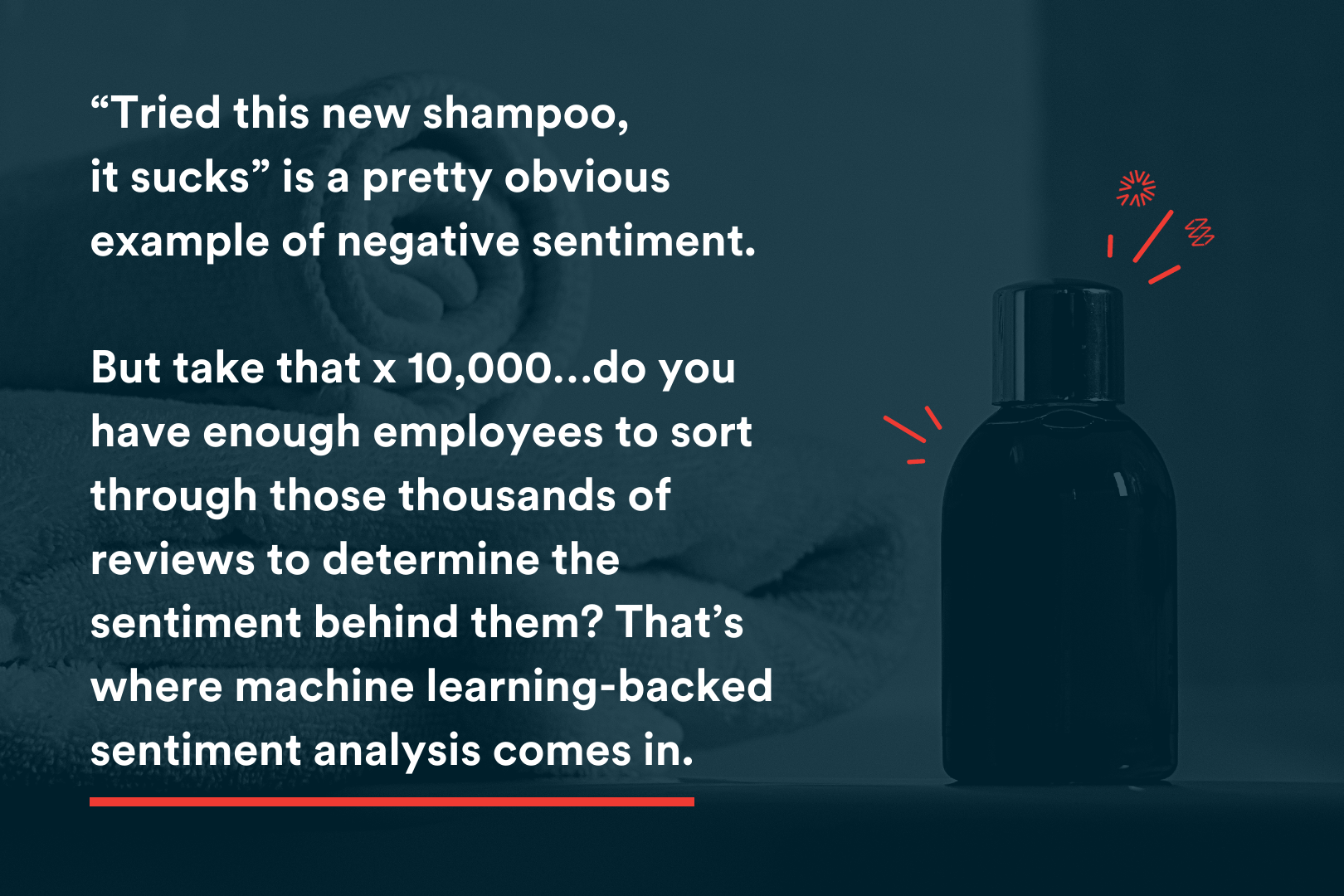artificial intelligence | machine learning | sentiment analysis
What’s the best way to know how people really feel about your business, product, or service?
Sales are certainly one metric. If your sales increase, that’s a sign that people appreciate what you’ve put in the market. But this metric is imperfect, as it could also suggest that you have a product or service that’s so valuable, people are willing to overlook minor or even major inconveniences.
Reviews are another option. You look at places that allow users to rate products and companies and use what you find as a barometer of how you’re doing. But depending on your size and type of organization (for example, B2B vs. B2C), this might provide an incomplete picture of audience sentiment. For instance, people who have an outlying negative experience with your brand might be more likely to leave a review, or it could be skewed the other way by employees or influencers who don’t provide an accurate representation of your overall brand interactions.
Another option is focus groups. You gather an audience made up of your target customers or users, then provide them with a series of questions or even take them through your current product experience. You then gauge their responses and use them to guide your design, experience, and other facets of your offering.
But there’s one more option, one that relies on technology to filter through all the buzz that’s out there about your organization and products: sentiment analysis.
Sentiment analysis is growing more and more popular as machine learning and artificial intelligence programs become increasingly attainable for businesses of all sizes. But what is sentiment analysis, and how can it be put to work for your organization?
Keep reading to find out.
Sentiment Analysis: Defined
Sentiment analysis is a process, usually backed by machine learning or artificial intelligence, that involves parsing sources of data to determine whether the prevailing opinion of a given topic (typically a business, a product, or a service) is positive, negative, or effectively neutral.
Why is this necessary? Because the ability to scale hinges on being able to offload certain tasks to artificial intelligence systems. A human being would have no trouble parsing a single sentence to determine if the sentiment behind it is negative or positive. “Tried this new shampoo, it sucks” is a pretty obvious example of negative sentiment that 99.99% of readers would understand.
But imagine there isn’t just one, but 10,000 or more sentences along those lines. Do you have enough employees to sort through all of those reviews to determine the sentiment behind them? Is that the most productive way to gauge responses to your product or service?
Probably not. And that’s where AI-driven sentiment analysis comes in. With the right program, you can feed in all the necessary data to determine what the response is to a new product launch, your business overall, or anything else with a sufficiently large data source to pull from.
How Does Sentiment Analysis Work?
A sentiment analysis program monitors for key signals and markers that suggest the intention behind the responding user.
Consider the previous example, “Tried this new shampoo, it sucks.” In this scenario, one word stands out, and that word is “sucks.” A positive sentiment would almost never use that word. So a program will look for a marker such as that, as well as other words and elements of sentence structure to make the determination that, indeed, sentiment behind this product is negative.
Examples of negative sentiment that a program could pick up on include obvious words such as terrible, awful, bad, etc., while examples of positive sentiment would be things like wonderful, great, satisfied, etc.
Those are the most obvious examples, but a program that can only scan for those may not be sufficient for your needs. That’s why sentiment analysis also looks out for other, less obvious terms that nevertheless signify a positive or negative opinion about a given thing. Words like didn’t, return, late, or okay could also signify a negative experience, while early, helped, done, or again could signify a positive experience.

What’s great about machine learning is, as more and more data becomes available, the program will learn these signals based on the topic in question and can theoretically get better at sorting the negative and the positive over time.
It's not just words themselves that are parsed. It’s also the context the words appear in. Sentiment analysis can look at the overall conversation surrounding a given topic. If two people on a social media channel are discussing the value of something, a sentiment analysis system can analyze their conversation and take into account where and how the words appear, rather than just the words themselves, making a better overall determination of the overall sentiment of the topic in question.
Where Does Sentiment Analysis Occur?
For sentiment analysis to be worthwhile, you need a lot of data and conversations surrounding a given thing. Which leaves only a few places where it’s possible to really embark on an ambitious sentiment analysis program.
Social media is one spot that’s ripe for sentiment analysis. This is where you get a pure, unvarnished look at how people, particularly users and customers, feel about your product, service, or organization.
Because it’s impossible for employees to sift through all of Twitter or Facebook to see the wide variety of opinions on a given topic, AI-driven sentiment analysis is crucial for capturing honest conversations about your brand. You could have a sentiment analysis program that examines one particular outlet, like TikTok, or a program that brings together the totality of the social conversation across numerous platforms.
You can also go BIG and engage in sentiment analysis across the wider world of the internet at large. In this case, a sentiment analysis program would crawl through forums, blogs, review sites, and any other areas of conversation to determine the overall picture of a given thing. Or you can get specific and drill down into any one of these areas.
Depending on your size and usage metrics, you might also be able to apply sentiment analysis to your internal infrastructure, such as employee forums, support hubs, and any other organization-sponsored spot where users congregate to share opinions. With a robust sentiment analysis operation, you can aggregate typical customer concerns to see commonalities, then use those to guide your future roadmap.
Gauging Sentiment to Define Strategy
Why is sentiment analysis important? Because if you get it right, and you have a true picture of the buzz around your business, product, or service, you can use that conversation to address issues and obstacles you may not have known existed.
These insights can and should drive your strategy, lead you to reconsider assumptions, and cause your company to constantly evaluate where you stand with customers. Otherwise, you’re operating in a vacuum, and the information you glean from other sources could be biased one way or the other, causing significant deviations to your roadmap that weren’t warranted.
Sentiment analysis can correct these deviations, and lead to new and exciting innovations you would never uncover otherwise.
Ready to get started with sentiment analysis? Contact Aviture to learn how to bake it into your ongoing strategy, as well as what you’ll need to build the right tool for the job.





